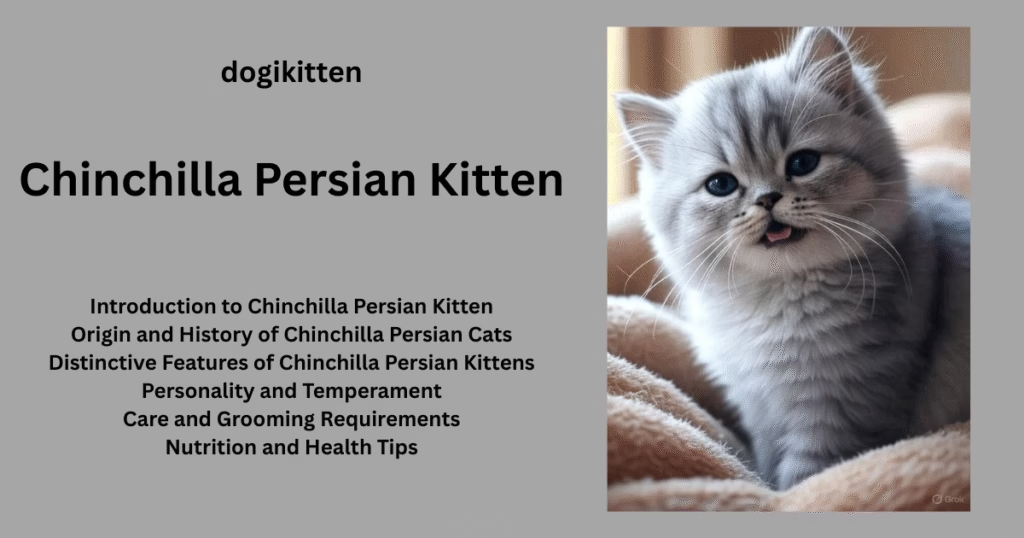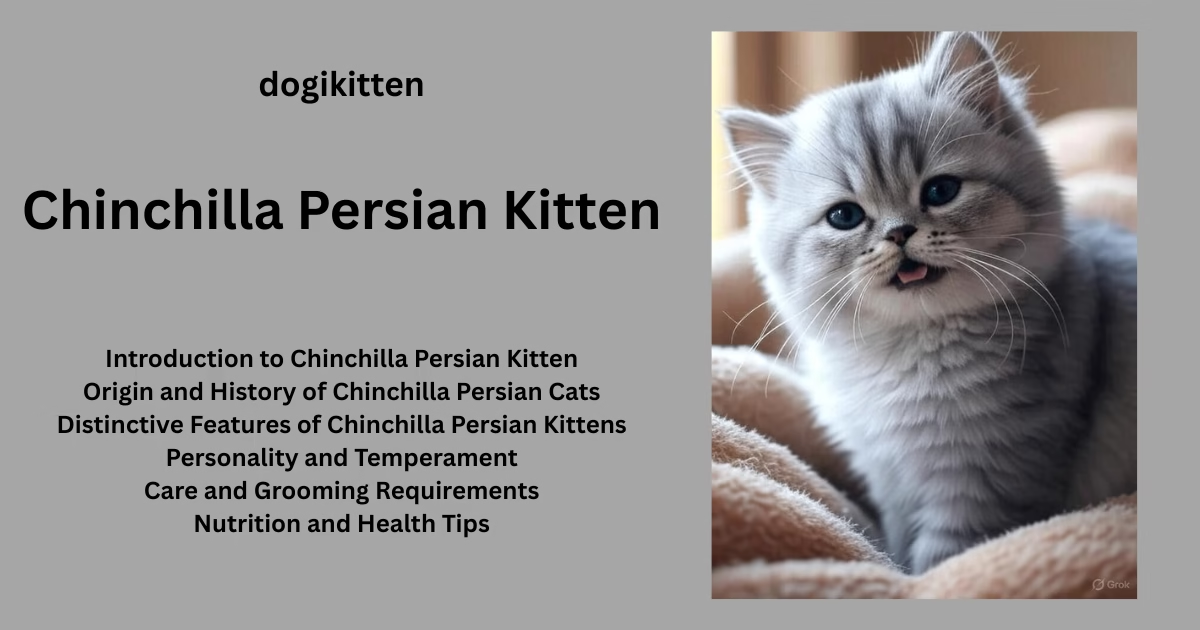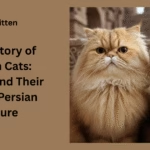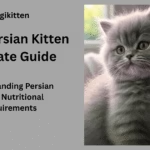
Discover the complete guide to raising a Chinchilla Persian kitten—from breed history and temperament, to grooming, health, training, and FAQs. Expert advice for prospective kitten owners!
1.Introduction
2.Breed History & Origins
3.Defining the Chinchilla Persian Kitten
4.Physical Characteristics
5.Temperament & Behavior
6.Health & Common Issues
7.Care & Grooming Essentials
8.Nutrition & Feeding
9.Training & Socialization
10.Environment & Daily Life
11.Bringing Your Kitten Home
12.Bonding & Enrichment
13.Cost & Adoption vs. Breeder
14.Similar Persian Varieties (Including Persian Kittens)
15.Conclusion
16.FAQ
1. Introduction
🐾 Introduction: The Enchanting World of Chinchilla Persian Kittens
The world of cats is full of charm, elegance, and mystery—but few breeds embody these qualities quite like the Chinchilla Persian kitten. With its shimmering silver-tipped coat, luxurious fur, expressive emerald or blue-green eyes, and dignified yet affectionate temperament, the Chinchilla Persian is often considered the royalty of feline breeds. Whether you are a cat lover considering your first kitten or an experienced Persian cat parent looking to understand this unique variant, this comprehensive guide will walk you through everything you need to know.
The Chinchilla Persian is not a separate breed, but rather a specific color variant within the larger Persian cat breed, which is one of the oldest and most beloved breeds in the world. The term “Chinchilla” refers to the striking coat pattern that gives the fur a sparkling, silvery-white or golden sheen—reminiscent of the chinchilla rodent, known for its fine, silky fur. Chinchilla Persians are often described as “living chinchilla dolls” due to their dainty features and calm, endearing expressions.
But don’t let their beauty fool you—these kittens require a lot of care. Known for their thick double coats and sensitive eyes, Chinchilla Persian kittens demand daily grooming and a peaceful environment. In return, they offer unwavering loyalty, affectionate companionship, and a serene presence that fills the home with warmth and grace.
What sets Chinchilla Persians apart from other Persian varieties—like traditional doll-face or peke-faced Persians—is not just their aesthetic appeal, but also their moderate facial structure and often better respiratory health. This makes them ideal for families who love the Persian personality but want a slightly less high-maintenance variant in terms of health and breathing issues.
2. Breed History & Origins
The chinchilla coloration first emerged in England in 1882 due to a spontaneous color-inhibitor mutation in Persians, leading to silver and golden-tipped fur 📜 Breed History & Origins of the Chinchilla Persian Kitten
To truly appreciate the elegance of the Chinchilla Persian kitten, it’s important to understand its fascinating origin—a blend of genetics, beauty, and aristocratic refinement that dates back more than a century. While the Chinchilla Persian is a specific color variety of the Persian breed, its development holds a unique place in feline history, marked by selective breeding and royal admiration.
🐱 The Origins of the Persian Cat
The Persian cat is one of the oldest and most iconic cat breeds in the world. Its roots trace back to ancient Persia (modern-day Iran), where long-haired cats were admired for their soft coats and regal demeanor. These cats made their way to Europe in the 1600s, brought by traders and explorers who were captivated by their beauty.
The Persian’s popularity surged in Victorian England, where they became favored pets among aristocrats and royalty. Queen Victoria herself owned a blue Persian cat, which further propelled the breed’s prestige and desirability across Europe. As breeders began refining the Persian’s features—such as its round face, short nose, and thick coat—it became the breed we recognize today.
🌟 The Birth of the Chinchilla Variety
The Chinchilla Persian was not part of the original Persian bloodline. It was developed in England in the late 1800s, and its creation is credited to the dedication of cat fanciers who wanted to produce a Persian with a sparkling, silvery appearance.
The first recognized Chinchilla Persian was a male cat named “Silver Lambkin”, born in 1882. He was the result of a deliberate breeding experiment by Mrs. Vallence, who mated a smoke-colored Persian with a silver tabby to produce a kitten with a light undercoat and black-tipped fur. Silver Lambkin went on to become a foundation stud for the Chinchilla line and was described as having a “shimmering silver coat” unlike anything seen before.
Silver Lambkin’s legacy was so important that his body was eventually preserved and displayed at the Natural History Museum in South Kensington, London, for many years—a testament to his significance in feline breeding history.
The Chinchilla variety quickly gained popularity and was officially recognized as a distinct color class by The Governing Council of the Cat Fancy (GCCF) in 1901, under the “Silver Persian” category. Over time, more color variations emerged, including Golden Chinchilla Persians, which featured a warm golden hue instead of silver.
🐾 What “Chinchilla” Actually Means
The term “Chinchilla” in this context refers to the pattern of the coat rather than the breed. It is derived from the Chinchilla rodent, a South American animal known for its incredibly soft, dense, and shiny fur. The Chinchilla Persian’s coat mimics this effect—with a white or cream undercoat and delicate black or golden tips—giving the illusion of a glowing, sparkling surface.
There are two primary types:
- Silver Chinchilla Persians: White undercoat with black tipping.
- Golden Chinchilla Persians: Creamy undercoat with golden or apricot tipping.
Their mesmerizing eyes—usually blue-green or emerald with dark eyeliner-like rims—further enhance the breed’s dramatic and enchanting look.
⚖️ Breed Standards and Recognition
Though Chinchilla Persians are genetically Persians, they are often judged separately in cat shows due to their distinct appearance. Different cat fancier associations recognize them in slightly different ways:
- CFA (Cat Fanciers’ Association): Recognizes the Chinchilla as part of the Persian division, under the shaded and smoke category.
- GCCF (UK): Sometimes treats Chinchilla Persians as a distinct color breed.
- TICA (The International Cat Association): Groups them under longhair Persians but acknowledges their unique coat pattern.
One interesting note is that Chinchilla Persians typically have a slightly less flat face (doll-faced) compared to modern show Persians, whose extreme brachycephalic features can lead to health issues. This makes Chinchilla Persians more appealing to families looking for a visually stunning cat with a more natural facial structure.
🏰 A Royal Reputation
During the 20th century, Chinchilla Persians became symbols of refinement and luxury. They were often featured in advertising, artwork, and films, reinforcing their image as “the aristocrats of the feline world.” Their glamorous appearance and quiet demeanor made them the perfect choice for well-to-do homes and cat lovers who valued serenity and style.
Today, Chinchilla Persian kittens are still highly prized. Because of the care required to maintain their luxurious coats and their comparatively rare coloring, they are considered one of the more exclusive and expensive Persian varieties. Their popularity remains strong among breeders, cat show participants, and pet lovers alike. The breed was later favored by British royalty, helping cement its status. Its official recognition by breed registries like GCCF followed in 1901.
3. Defining the Chinchilla Persian Kitten
🐱 Defining the Chinchilla Persian Kitten (Short Explanation)
A Chinchilla Persian kitten is a rare and elegant variety of the Persian cat breed, known for its luxurious long coat with a white or cream undercoat delicately tipped in silver or gold. This gives the kitten a shimmering, sparkling appearance—similar to the fur of the South American chinchilla rodent, which inspired the name.
Unlike modern Persian cats with extremely flat faces, Chinchilla Persians often have a more moderate or “doll-face” profile, which makes them not only visually appealing but also healthier in terms of breathing and eye drainage.
They are cherished for their:
- Silky, thick fur
- Striking blue-green or emerald eyes outlined in black
- Gentle and affectionate temperament
- Quiet, calm nature ideal for peaceful homes
Though not a separate breed, the Chinchilla Persian is a distinct and highly prized color variant within the Persian breed, blending beauty, grace, and companionship.
4. Physical Characteristics
✨ Physical Characteristics of the Chinchilla Persian Kitten
The Chinchilla Persian kitten is renowned for its stunning and regal appearance. Here are its key physical traits:
- Coat: Long, dense, and silky with a pure white or creamy undercoat delicately tipped in silver (Silver Chinchilla) or golden tones (Golden Chinchilla), giving a sparkling effect.
- Eyes: Large, expressive, and round—typically green, blue-green, or hazel—with black “eyeliner” rims that enhance their dramatic look.
- Face: Rounded head with a short, slightly snub nose (less flat than extreme Persian types), small ears with rounded tips, and a sweet, gentle expression.
- Body: Medium to large size with a compact, muscular, and cobby build; short legs and a bushy, plume-like tail.
- Paw Pads & Nose: Silver Chinchillas have black paw pads and a brick red nose, often outlined in black.
These kittens grow into majestic-looking cats, combining the luxury of long-haired breeds with a soft, glowing coat and doll-like features.
5. Temperament & Behavior
🧠 Temperament & Behavior of the Chinchilla Persian Kitten
Chinchilla Persian kittens are known for their sweet, calm, and affectionate nature. They are gentle companions who thrive in quiet, stable environments and form strong bonds with their family.
Key temperament traits include:
- Affectionate but not overly demanding—enjoy cuddles but also value their independence.
- Quiet and peaceful, rarely meowing unless necessary.
- Shy around strangers, but loyal and loving once they trust you.
- Not overly active—they prefer lounging, watching from windows, or gentle play with soft toys.
- Good with older children and calm pets, as they dislike loud noises or rough handling.
These kittens are ideal for homes that offer a relaxed atmosphere and consistent routines, making them wonderful lap companions and indoor pets.
6. Health & Common Issues
🏥 Health & Common Issues of the Chinchilla Persian Kitten
While Chinchilla Persian kittens are generally healthy when bred responsibly, they are prone to some health concerns common in Persian cats due to their genetics and facial structure.
Key health issues include:
- Brachycephalic features: Their short nose can lead to breathing difficulties and tear staining.
- Polycystic Kidney Disease (PKD): A genetic condition that can affect kidney function—DNA testing is recommended.
- Eye problems: Including excessive tearing, infections, and corneal ulcers due to their large, exposed eyes.
- Dental issues: Crowded teeth may require regular dental care.
- Skin problems: Their thick coat and facial folds can trap dirt and moisture, leading to infections if not cleaned regularly.
With proper grooming, routine vet check-ups, and a healthy diet, many of these issues can be managed or prevented, allowing your kitten to live a long, happy life.
7. Care & Grooming Essentials
🧴 Care & Grooming Essentials for Chinchilla Persian Kitten (Short Explanation)
Chinchilla Persian kittens require consistent and gentle care to keep their luxurious coat and overall health in top condition.
Essential grooming tips include:
- Daily brushing: Prevents tangles and mats in their thick, long fur.
- Regular bathing: Monthly baths help maintain coat cleanliness and reduce oil buildup.
- Eye cleaning: Wipe eyes daily with a soft, damp cloth to manage tear stains.
- Ear cleaning & nail trimming: Check ears weekly and trim nails every 1–2 weeks.
- Dental hygiene: Brush teeth regularly to prevent plaque and gum issues.
Their grooming routine not only keeps them beautiful but also strengthens the bond between pet and owner. Consistency is key for a healthy and happy Chinchilla Persian kitten.
8. Nutrition & Feeding
🥣 Nutrition & Feeding for Chinchilla Persian Kitten (Short Explanation)
Proper nutrition is essential for the growth, coat health, and overall well-being of a Chinchilla Persian kitten.
Key feeding tips include:
- High-quality kitten food: Choose specially formulated food for Persian or long-haired breeds to support healthy skin, coat, and digestion.
- Hairball control: Include foods or supplements that reduce hairball formation from grooming.
- Portion control: Feed measured meals 2–3 times a day to prevent overeating and obesity.
- Fresh water: Provide clean water at all times—water fountains encourage more drinking.
- Avoid human food: Stick to vet-approved diets and avoid feeding table scraps.
Balanced nutrition supports their energy, immunity, and the maintenance of their signature silky fur.
9. Training & Socialization
🎓 Training & Socialization for Chinchilla Persian Kitten (Short Explanation)
Chinchilla Persian kittens are intelligent and gentle, making them easy to train and socialize with the right approach.
Key points:
- Litter training: Usually quick learners—just provide a clean, quiet litter box.
- Gentle handling: Start early with grooming and nail trimming to build comfort.
- Positive reinforcement: Use treats and praise for rewarding good behavior.
- Quiet socialization: Slowly introduce them to new people, pets, and spaces to reduce shyness.
- Play sessions: Encourage daily gentle play to keep them mentally and physically active.
With patience and consistency, your kitten will grow into a well-adjusted, confident companion.
10. Environment & Daily Life
🏡 Environment & Daily Life of a Chinchilla Persian Kitten (Short Explanation)
Chinchilla Persian kittens thrive in calm, clean, and cozy indoor environments that suit their quiet nature and grooming needs.
Key essentials:
- Indoor living: Best kept indoors to protect their coat and health.
- Quiet surroundings: They prefer peaceful homes without loud noises or chaos.
- Comfortable space: Provide soft bedding, warm spots, and access to scratching posts.
- Cleanliness: Maintain a tidy litter box and grooming area to keep them healthy.
- Daily routine: Stick to regular feeding, grooming, and play schedules—they love consistency.
Creating a stress-free, loving space helps your Chinchilla Persian kitten feel secure, happy, and relaxed every day.
11. Bringing Your Kitten Home
🏠 Bringing Your Chinchilla Persian Kitten Home (Short Explanation)
Welcoming a Chinchilla Persian kitten into your home is a joyful experience—but it requires preparation and patience.
Key tips:
- Safe space: Set up a quiet, cozy area with a bed, litter box, food, and water.
- Gradual introduction: Let the kitten explore slowly and get used to your home one room at a time.
- Familiar items: Use toys or blankets with familiar scents to ease the transition.
- First vet visit: Schedule a health check-up and start vaccinations early.
- Routine & bonding: Stick to a feeding/grooming schedule and spend quiet time together to build trust.
A calm, well-prepared environment helps your kitten settle in quickly and feel at home.
12. Bonding & Enrichment
💞 Bonding & Enrichment for Chinchilla Persian Kitten (Short Explanation)
Building a strong bond with your Chinchilla Persian kitten is key to a happy, loving relationship.
Key ways to bond and enrich:
- Gentle grooming: Daily brushing becomes a bonding ritual your kitten will enjoy.
- Interactive play: Use soft toys or feather wands to stimulate their mind and body.
- Quiet cuddle time: They love sitting beside you or on your lap—be patient and calm.
- Routine: Consistent daily activities help your kitten feel secure and connected.
- Enrichment: Offer scratching posts, climbing trees, and cozy hideouts for mental stimulation.
With love and patience, your Chinchilla Persian kitten will become a loyal, affectionate companion.
13. Cost & Adoption vs. Breeder
💰 Cost & Adoption vs. Breeder (Short Explanation)
Owning a Chinchilla Persian kitten can be a rewarding but costly commitment.
Cost:
- Purchase price: ₹30,000 to ₹80,000 (or $500–$1500+), depending on lineage and breeder reputation.
- Initial setup: Litter box, bed, grooming tools, toys, and carrier can add ₹5,000–₹10,000 ($100–$200).
- Ongoing costs: Food, grooming, vet visits, and insurance.
Adoption vs. Breeder:
- Breeder: Offers purebred kittens with health screening and pedigree—but more expensive.
- Adoption: Lower cost, and you may rescue a cat in need—but may have limited information on health history or genetics.
Choose a reputable breeder or certified shelter to ensure your kitten is healthy, well-socialized, and ethically raised.
14. Similar Persian Varieties (Including Persian Kittens)
🐾 Similar Persian Varieties (Including Persian Kittens) – Short Explanation
Chinchilla Persian kittens are part of the larger Persian cat family, but several other Persian varieties also share similar traits with slight differences in appearance and temperament.
Common Persian Varieties:
- Traditional (Doll-Faced) Persian: Features a round face with a normal nose (not flat); healthier and easier to care for than modern Persians.
- Peke-Faced Persian: Has a very flat face (like a Pekingese dog); popular in shows but prone to breathing and eye issues.
- Himalayan Persian: A cross between Persian and Siamese breeds, with color-pointed fur and striking blue eyes.
- Exotic Shorthair: A short-haired version of the Persian, requiring less grooming but sharing the same sweet temperament.
- Golden Persian: Very similar to Chinchilla, but with a warm golden or apricot coat instead of silver.
All Persian kittens are known for their calm nature, long coats (except Exotic Shorthairs), and affectionate personalities—but Chinchilla Persians stand out for their sparkling coat and expressive eyes.
16. Conclusion
The Chinchilla Persian kitten is a stunning, affectionate companion requiring effort and dedication. With proper grooming, nutrition, veterinary care, and love, you can enjoy many peaceful and joyful years together. Whether you choose adoption or a breeder, this elegant, silver-tipped feline makes a rewarding addition to a calm, caring home.
15. FAQ
Q1: How long will a Chinchilla Persian live?
12–17 years, depending on health and care
Q2: Do they shed a lot?
Yes—daily grooming essential to manage shedding and prevent mats .
Q3: Are they good with children and other pets?
Best with calm older children and other pets if introduced gently.
Q4: Are they hypoallergenic?
No—they shed allergens via skin and fur; not suitable for allergy sufferers.
Q5: How often should I groom?
Daily brushing, plus bathing every 4–6 weeks and weekly eye/face cleaning.
Q6: What health tests do breeders do?
Genetic screening for PKD, HCM, and brachycephalic impacts should be performed .











2 thoughts on “Chinchilla Persian Kitten”